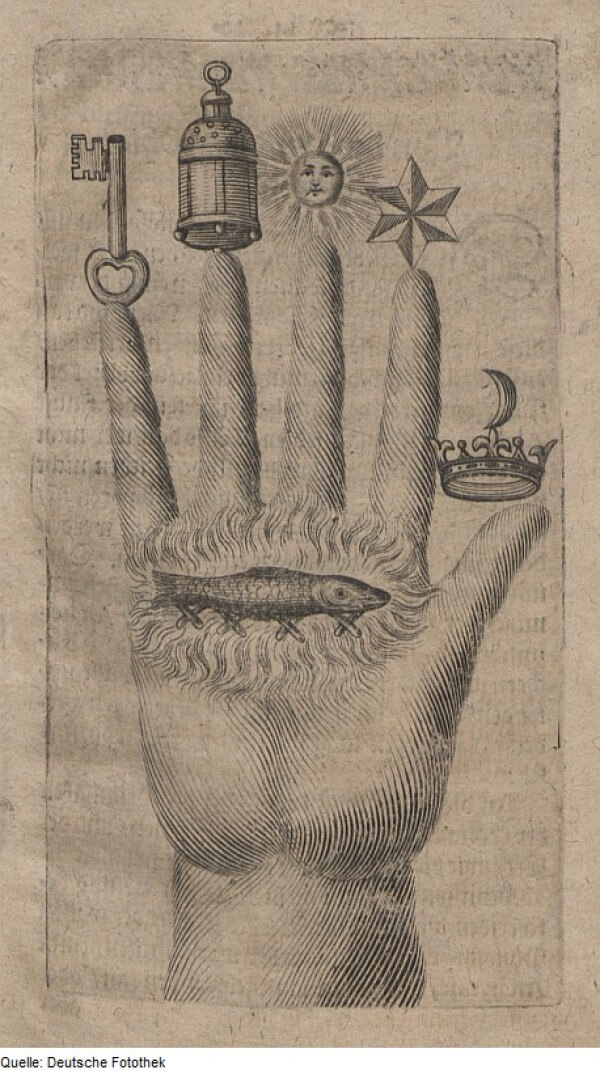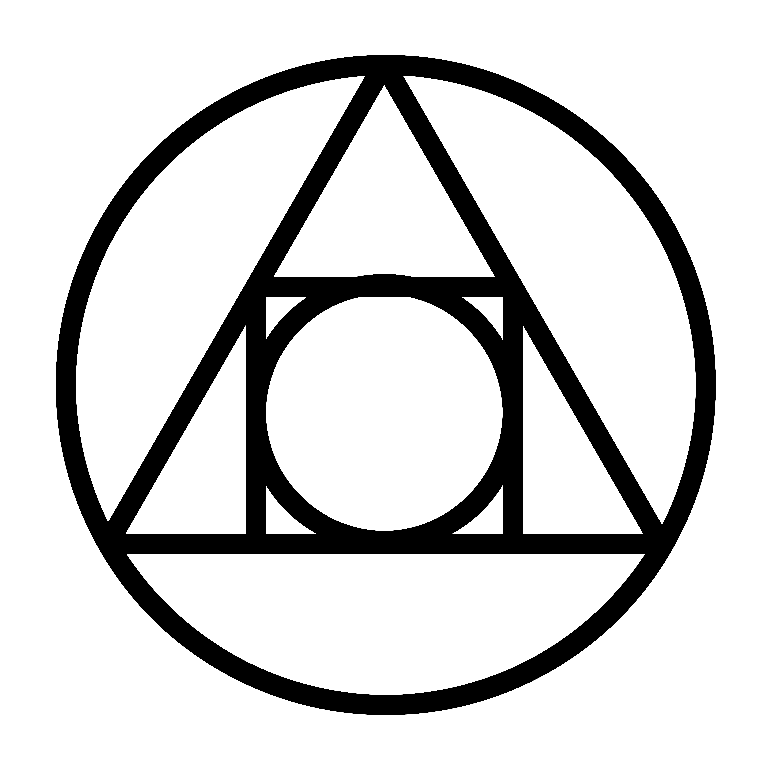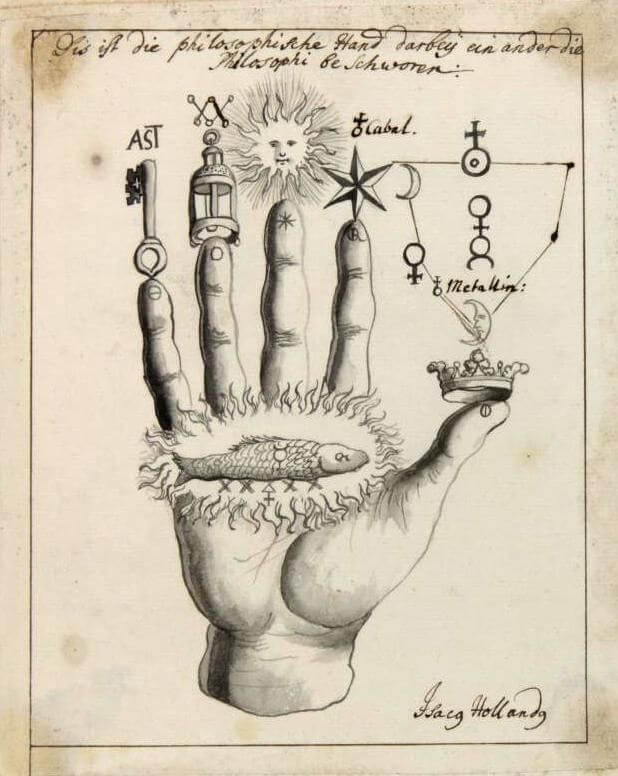The Hand that Holds the Secret
“Nature delights in Nature, Nature conquers Nature, Nature contains Nature.”
— Anonymous, Book of the Hand of the Philosophers, 17th century
In the quiet archives of European alchemy, there exists an emblem so deceptively simple it could be mistaken for a devotional sketch. A human hand, open to the viewer, floats within a field of symbols: stars, keys, flames, a fish swimming in a circle of fire. Yet this “Hand of the Philosophers” is not the gesture of benediction—it is a map.
To the initiated, it shows the structure of the Great Work itself, the invisible architecture of transformation that underlies both laboratory and soul. The fingers name the elements; the palm reveals their unification. Like the Vitruvian Man or the Tree of Life, it is a visual theology of creation—a revelation of how spirit becomes matter and how matter becomes divine.
A Legacy in the Shape of a Hand
The earliest known version of the Hand of the Philosophers appears in the writings attributed to Johann Isaac (or J.J.) Hollandus, collected posthumously in Chymische Schrifften (Vienna, 1773). Hollandus was one of several pseudonymous “Hollanduses” who wrote practical manuals for adepts between the 16th and 18th centuries.
The emblem likely predates that publication by more than a century, echoing the emblematic tradition of early modern Europe—works like Michael Maier’s Atalanta Fugiens and the engravings of Basil Valentine. In these symbolic tableaux, the alchemists encoded laboratory methods, spiritual ethics, and cosmic law in a single image.
Each hand-drawn reproduction of the emblem varies slightly, but the structure remains constant: five extended fingers, each labeled with an alchemical agent; a fish in the palm, circled by fire; and inscriptions identifying each element with a stage of the Magnum Opus, the Great Work of transformation.
The Thumb: Saltpeter and the Crown of Completion
“The thumb closes the grasp, as perfection closes the circle of the Work.”
The thumb, placed apart from the fingers yet essential to their power, symbolizes Saltpeter (niter)—the crystalline foundation of all salts and the alchemist’s “King of Minerals.” It embodies perfection and fixation, the final stage where volatility is mastered.
Saltpeter was not merely a chemical substance but a metaphor for the perfected body—the physical vessel capable of enduring illumination. In the emblem, it represents the finishing power of Nature: what the ancients called the corpus glorificatum, the glorified body of the Stone.
The Index Finger: Vitriol and the Descent of Spirit
“Visita Interiora Terrae Rectificando Invenies Occultum Lapidem.”
(Visit the interior of the earth; by rectifying, you will find the hidden Stone.)
Above the pointing finger gleams the six-pointed star—the Seal of Vitriol. The acronym hides an instruction: V.I.T.R.I.O.L. is both chemical and mystical. To “visit the interior” means not only to refine matter but to descend into the depths of the self, confronting the dross of ignorance.
Vitriol was the universal solvent of the alchemists, capable of dissolving metals and egos alike. Its position on the index finger—used for pointing and direction—indicates the transformative path of the soul. The alchemist must direct his inner fire toward purification, allowing spirit to act upon matter without destruction.
The Middle Finger: Gold and the Purity of the Heart
The tallest of the fingers bears the symbol of the Sun (Sol), the royal metal Gold. Some sources, including Hollandus, interpret it as sal ammoniac, the volatile salt that mediates between fire and water. Both meanings converge on the same principle: purity through balance.
Gold, in alchemy, is never merely metal. It is the heart perfected—the inner sun within man. This finger reaches heavenward, a reminder that illumination is the natural direction of all refined substance. Its brilliance is moral as well as chemical: to become gold is to become transparent to light.
The Ring Finger: The Lantern of Wisdom
“He who lights the lantern must first make it transparent.”
On the ring finger rests a small lantern, labeled by some manuscripts as Alum, the clarifying salt. Alum whitens and fixes colors in dyeing; in alchemy, it fixes insights in consciousness.
Its placement on the ring finger—traditionally the finger of union—symbolizes the marriage of intellect and intuition. Here, wisdom is not accumulation but illumination. The lantern burns with a steady flame, guiding the practitioner through the long night of the Nigredo, the black stage of dissolution.
The Little Finger: The Key of Common Salt
The smallest finger holds a key—humble, practical, indispensable. It represents common salt, the “base matter” from which all other transformations proceed. The key both locks and unlocks; it is the paradox of incarnation itself.
Salt is the mediator between body and spirit, the hinge of creation. To the alchemist, it is the principle of preservation and crystallization—what holds form together. The key thus represents mastery of the material plane, where spirit must dwell without decay.
The Palm: Mercury and the Living Soul
“In the midst of the Work swims Mercury, the Fish of the Philosophers.”
At the center of the hand lies a fish, encircled by flames. The fish is Mercury, the living, liquid spirit of the Work. It moves between solid and vapor, life and death, above and below.
The fire that surrounds it is Sulphur, the principle of activity and desire. Together they form the coniunctio oppositorum—the union of opposites—where all alchemical operations converge.
In this circle, the Work becomes self-sustaining: fire feeds mercury, mercury tempers fire. Their dance within the palm is the secret heart of alchemy—the place where the elements reconcile and creation renews itself.
The Hand as a Map of Creation
The Hand of the Philosophers functions as both cosmogram and anatomy. Each finger corresponds to an alchemical principle—Salt, Sulphur, Mercury, Vitriol, and Saltpeter—and to one of the classical elements.
Seen this way, the hand is not human but cosmic. The thumb anchors the elements, the fingers extend the powers, and the palm gathers them into unity. Just as the human hand acts upon the world, the Divine Hand shapes the cosmos.
To meditate on this emblem is to recognize the self as the instrument of creation. The alchemist’s body, mind, and materials are one continuum; each operation in the laboratory mirrors a transformation within the soul.
The Inner Meaning: Alchemy as Embodied Philosophy
When Hollandus inscribed his symbols, he was not merely cataloguing reagents. He was describing a psychophysical process—the refinement of consciousness through engagement with matter.
Saltpeter represents the purification of the body; vitriol, the cleansing of the soul; gold, the illumination of the heart; alum, the wisdom of mind; and salt, the grounding of all in stable being. Mercury, held in the palm, is the living awareness that unites them all.
Each component interacts not sequentially but cyclically. The Work begins and ends in the same place: the hand that acts becomes the hand that receives.
From Symbol to Realization
The enduring power of the Hand of the Philosophers lies in its subtle pedagogy. It teaches through correspondence rather than instruction, inviting contemplation rather than command.
To read it properly is to engage in a silent experiment:
-
Dissolve rigidity (Vitriol).
-
Refine the heart (Gold).
-
Illuminate understanding (Lantern).
-
Ground the light (Salt).
-
Seal it in perfection (Saltpeter).
Each step leads inward. The emblem’s simplicity conceals the entire cosmology of the alchemists—a human microcosm expressing divine order.
Conclusion: The Gesture of the Eternal Artisan
“The Work is not done by hands, yet without the hands it cannot be done.”
— Paracelsus
In the end, the Hand of the Philosophers is both a tool and a prayer. It reminds us that creation is manual—that the divine crafts through the human gesture. Every act of transformation, whether in flask or heart, begins when the hand opens to receive.
To contemplate this image is to remember that perfection is not imposed but revealed—like a hand emerging from fire, luminous, unburned, holding the secret seed of its own renewal.
I was not able to find a digital version of The Hand of the Philosophers from J.J. Hollandus but it can be found in the book Opuscula Alchimica
You can hold Opuscula Alchimica in your philosophical hands by clicking here.
— Jonas Verity


